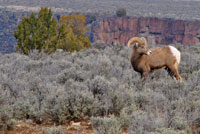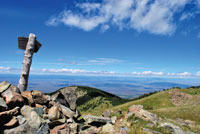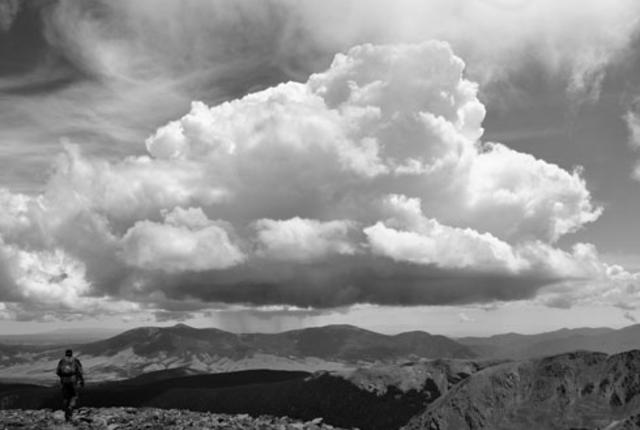By the time I woke, my body temperature had dropped to the point that I was shivering violently. I rolled over into the fetal position and my sleeping bag squished. Someone was calling my name. I could hear rain. Then my little pup tent collapsed around me.
Outside, people were yelling and scattering among the piñon and juniper. The sky was pink except for the bolts of lightning breaking the night, careening overhead and crashing into the ponderosas on a hill across the valley. There were piles of hail a foot deep and a watery muck that floated up past my ankles. Then those lofty cottoncandy clouds opened up with a tremendous dump of large, wet snowflakes. By the time I’d found my boots, I was caught in a full-on blizzard and couldn’t stop shaking. The only clothes around were a sopping pair of shorts and a muddy flannel. Throwing them on, I raced for the trucks parked somewhere out in the night.
It was springtime in New Mexico.
 Bighorn sheep thrive in and around the Rio Grande Gorge.
Bighorn sheep thrive in and around the Rio Grande Gorge.
Lobo Peak crowns the western portion of the Colombine Hondo Wilderness Study Area, north of Taos, the largest roadless area in the southern Rockies ecosystem. At 21 years old, I was a dropout from the University of New Mexico archaeology program. “What am I doing here?” I sat in class and wondered. I’d gotten it in my head that I could learn far more working out on a real live archaeological project. After a month of shameless begging, one of the crew chiefs took pity. I was hired onto a team surveying the path of a giant proposed oil-and-gas pipeline running from Albuquerque to the Four Corners, with branches to Gallup, Chama, and on up into southwestern Colorado.The problem from the start was simple: The Texas oil executives who traced that pipeline path across the map of our state had never walked the land. They had no idea what they were getting into. They had no idea what they were getting us into. The pipeline was pointed through some of the wildest, roughest, and most archaeologically rich land in all of North America.
Two weeks later, the snow had melted, the mud had nearly cemented, and a searing wind was blowing out of the southwest. Our truck overheated, so our little crew of 10 walked northeast through thick stands of piñon and juniper trees along the proposed pipeline route, looking for help. The path was a dusty red. We could see north to the San Juan Mountains in Colorado, west to the Chuskas in Arizona, and east to the peaks of the Sangre de Cristo range near Taos.
The crew trudging down the path that day was a microcosm of New Mexico. There was a Diné from Shiprock, a guy from Isleta Pueblo, a relocated rocker from Chicago, a gun lover from Indiana, a mouthy New Yorker who would go on to become a respected New Mexico archaeologist, a Hispanic from a defunct farming village, a former cowboy, and a very serious PhD candidate.
Eventually we came to a squat hogan and a single-wide scrunched up tight against a ruddy sandstone cliff and surrounded by fat little junipers. The man who answered the trailer door wasn’t thrilled, but he welcomed us with frybread straight from the cast-iron skillet, a bowl of meaty stew, and a horrific cup of coffee.
When his wife arrived, she wagged her finger. “There are ghosts all over out there! People have been living and dying out here for fifty thousand years! You’re stirring up them ghosts,” she said. “I don’t think this is a good idea. This is not a good idea.”
A few weeks later, while we were excavating an ancestral Puebloan site, one of the pipeline workers from Oklahoma drove up and sincerely wanted to know “why those Indians built their homes way out here, so far away from the cities?!”
He couldn’t comprehend that back a thousand years ago, some of the remote parts of New Mexico were far more heavily populated than they are now. He couldn’t comprehend that where we have cities now was not where people from 1,000 or 2,000 or 5,000 years ago built their towns or villages. He wasn’t the only one. The Texas oil executives certainly didn’t understand it. Seemingly, neither did the project managers at UNM. How could they not know all of this was out here?
The whole project ground to a snail’s pace. Our crew was finding archaeological sites no one had ever recorded before. In fact, we couldn’t walk more than a quarter-mile without running into another new site and then another and then another. By law, each site in the path of the pipeline had to be properly mapped, photographed, recorded, and ultimately excavated before the pipeline could be built. Poor management wasn’t my concern, however.
I was perhaps more content than I’d ever been. Growing up in southern Colorado with a New Mexico–enchanted family meant that we often headed south to explore. But for some reason I wasn’t ever taken with New Mexico like the rest of my family. “What are we doing here?” frequently crossed my lips.
I wasn’t asking that anymore. By May I had stopped returning to Albuquerque on my days off. I was less and less interested in the girlfriend waiting for me in the city and increasingly desirous to spend my free days along the back roads, hiking into long-lost ruins, and talking to the other New Mexicans I met along the way.
There was a very large Pueblo ruin buried in the caliche and sand near an empty spot on the map called Ram Mesa, out on the Navajo Nation. There didn’t appear to be anyone living nearby, but every morning an enterprising kid would show up with a cooler full of hot, fresh burritos. He made a fortune from us and then disappeared back into the cliffs and canyons.
That site spread out around the base of the mesa and took months to map and excavate. It was full of pottery styles from all over the Southwest. The people who had lived there traded with others in Mexico, Arizona, California, Utah, Colorado, and possibly beyond. It was slated to be torn up when the pipeline crews came through.
Day by day, I slowly learned to look out over the landscape and see where the towns and villages would have been and how the ancient New Mexicans would have used the land to alter watercourses, grow food, harvest trees, and travel. That land came completely to life as I spent more time out there, and the layers of history became clearly visible to me. So did my place in that history. I couldn’t feel anything but humbled.
In July the monsoon season arrived.
We could see it coming. For weeks the thunderheads built up every afternoon to the southwest. Then you could smell it, the sweetness of tropical moisture beginning to dominate the tang of desert dust. One day the sky went dark so fast, we raced to cover the site and get to camp. Too late. Coyote Canyon, a painfully sere little wash normally so dry even cactus went there to die, filled to the brim with a dangerous red, muddy flood. We spent the night sleeping in the trucks without our gear.
It rained for weeks.
On an October morning I woke, warm and dry in a new three-season tent. I lay there and listened to the gentle hiss of snow falling outside. Someone had a fire going, and then a pot of coffee. My equipment was better. I’d come to terms with living outside on the land in New Mexico. You just had to be prepared for anything.
Later that morning, our crew drove the highway to a small excavation site we’d found just northwest of Cuba. A great gray owl darted from the sage and made for the highway. A truck cruising from the opposite direction clipped the owl, and it spun against the asphalt and into the brush. I wrapped it in my coat and carried it to our truck.
It died. Right there in my hands it died. I wasn’t sad. I was amazed. Holding that bird and looking across the snowy sagebrush flats of the Jicarilla lands, the whole year filled my head all at once, and it was all about amazement, every bit of it. There was the vastness of the land, the perfectly sweet summer mornings, the soft winds that broke the heat and the harsh winds that bent you to your knees, the rains you could see coming for miles off, the powerful sun, the friends, the sweaty work, the discoveries, the seemingly endless drives, the hikes to places no cars could go …
“What am I doing here?” was no longer a question without an answer. New Mexico wasn’t a choice for me. It was something that happened to me. “Home” was the answer. ✜


